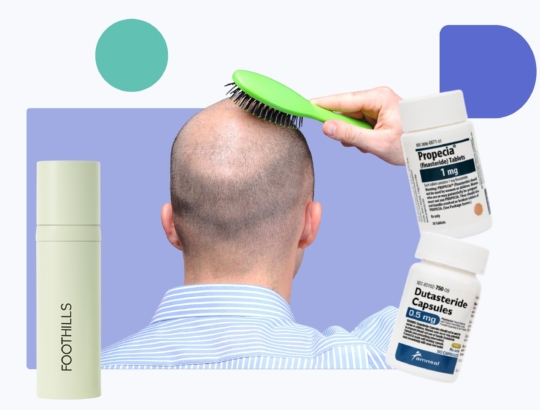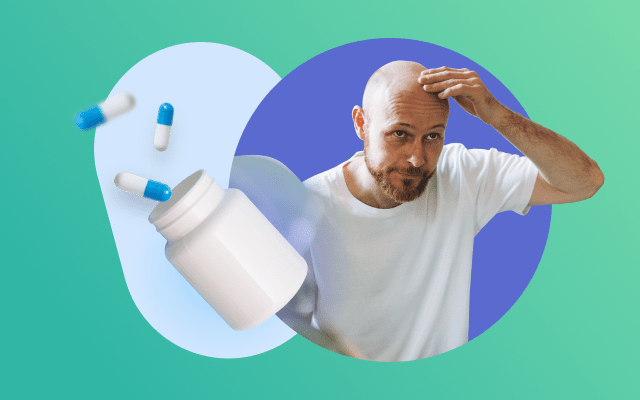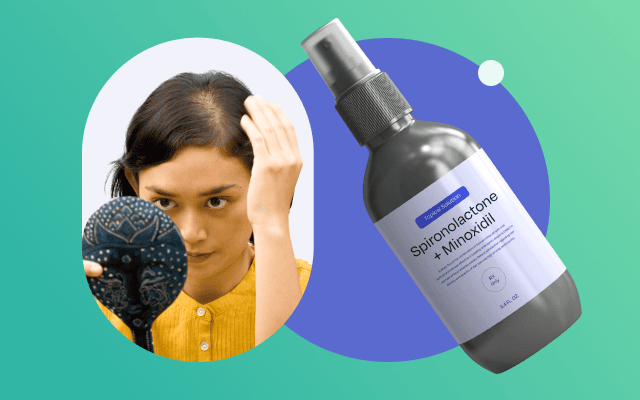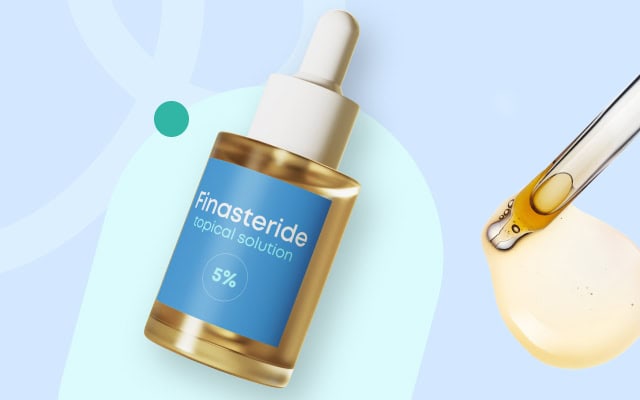Understanding compounded topical dutasteride
Dr. Alpana Mohta, board-certified dermatologist, talks about the off-label use of topical dutasteride in the treatment of male pattern baldness.
Table of Content:
What is topical dutasteride? | How to get a prescription? | Side effects | How to apply it? | Additional tips | FAQs
Our commitment to producing high-quality content:
The information presented in this article is based on scientific research and the professional advice of our Content Medical Reviewers, who are experts in the field of Dermatology. How we write our content →
What is topical dutasteride?
Dr. Alpana Mohta, board-certified dermatologist says that topical dutasteride is a compounded preparation that some licensed healthcare providers may prescribe for use on the scalp. It contains dutasteride, an FDA-approved active ingredient for oral use in benign prostatic hyperplasia (BPH). When prepared in topical form, it is considered an off-label compounded medication, which has not been reviewed or approved by the FDA for safety or effectiveness in treating hair loss.
Does topical dutasteride work?
There is limited published research exploring topical dutasteride. Because topical dutasteride is not an FDA-approved product, its safety and effectiveness for hair loss have not been established. Some healthcare providers and patients discuss topical dutasteride as one of several options, but whether it is appropriate depends on an individual consultation with a prescribing clinician.
Do you need a prescription for a topical dutasteride?
Yes, Dr. Mohta says that topical dutasteride is available only by prescription. A licensed healthcare provider must determine whether it is appropriate for an individual patient.
How to get an online prescription via Miiskin?
Miiskin connects you with board-certified dermatologists, who may prescribe FDA-approved generics or personalized compounded medications.
If you are interested in a customized formula, simply select Foothills as your pharmacy and place your medication order directly in the Miiskin platform. Foothills will send you a payment link, and once payment is completed, your medication will be shipped free via UPS 2-day delivery.
Transparent pricing: A consultation is typically around $59, and medication refills are around $39. The price of most Foothills formulas via Miiskin is $48.99 with a few exceptions being priced at $58.99 and some hair growth formulas priced at $68.99. You will not be enrolled in an automatic subscription, you will only purchase medication when you need it.
Important Disclaimer: Compounded medications are not reviewed by the FDA for safety or efficacy.
What are the possible side effects?
Because compounded topical dutasteride has not been evaluated by the FDA, there is limited information about its safety profile. Reported experiences may include local scalp irritation such as redness, itching, or dryness. Systemic absorption is possible, and because dutasteride carries warnings for potential effects on pregnancy, it is not recommended for women who are pregnant, may become pregnant, or are breastfeeding.
Disclaimer: Patients should consult a licensed healthcare provider to discuss risks, uncertainties, and monitoring before starting any compounded medication.
How to use topical dutasteride?
If prescribed, patients should carefully follow the instructions provided by their healthcare provider and the dispensing pharmacy. Compounded products may differ in strength, concentration, and form (e.g., dropper, spray), so there is no single standard dose.
- Wash and dry your hair/scalp with a towel: Ensure your scalp is clean and dry before applying topical dutasteride. Use a mild shampoo to wash your hair and scalp, then towel dry.
- Apply evenly: Part your hair to expose the scalp and apply the measured dose evenly across the affected areas. Most products also have the option of spraying. Usually 6 sprays will dispense 1 ml.
- Massage into the scalp: Gently massage the solution into your scalp to ensure absorption, avoiding vigorous rubbing to prevent scalp irritation.
- Wash your hands: Thoroughly wash your hands after applying the medication to remove any residual product.
- Allow to dry: Let the medication dry completely before using other hair products or going to bed.
Additional dermatologist tips
- Be consistent: Dr. Mohta advises using the medication consistently, typically twice a day, to maintain stable levels of the drug in your scalp.
- Do not overuse: Stick to the recommended dose, which is usually no more than 2 ml per day. Applying more than advised won’t enhance effectiveness and could increase the risk of side effects.
- Monitor for side-effects: Watch for potential side effects such as scalp irritation. If you notice any adverse effects, contact your healthcare provider immediately.
- Schedule regular check-ups: Regularly consult with your dermatologist to monitor your progress and make any necessary adjustments to your treatment plan.
Frequently asked questions about topical dutasteride
Is topical dutasteride FDA-approved?
No. The FDA has not approved any topical dutasteride product. Compounded versions are prepared by pharmacies on a prescription basis for individual patients.
Can women use topical dutasteride?
Because dutasteride carries warnings about potential birth defects, it is not recommended for women who are pregnant, may become pregnant, or are nursing. A licensed healthcare provider can discuss other options.
Can dutasteride be absorbed through the skin?
Dr. Mohta says that topical preparations may be absorbed through the skin, which is why handling precautions and medical supervision are necessary.
Is topical dutasteride a DHT blocker?
Yes, topical dutasteride is a DHT blocker. It inhibits the 5-alpha reductase enzyme in the scalp, which converts testosterone to dihydrotestosterone (DHT), a hormone that contributes to hair follicle miniaturization and hair loss.
Can I switch from oral to topical dutasteride?
Yes, Dr. Mohta says that you can switch from oral to topical dutasteride, but it should be done under the guidance of a healthcare provider. They can help determine the appropriate dosage and monitor for any changes in effectiveness or side effects.
Can you combine topical dutasteride and topical minoxidil together?
Some providers prescribe compounded solutions that contain both dutasteride and minoxidil. Whether that is appropriate depends on the prescriber’s judgment and patient needs.
Can topical dutasteride be applied to dirty hair?
For best results, Dr. Mohta says topical dutasteride should be applied to a clean scalp. Washing your hair and scalp with a mild shampoo before application ensures that dirt, oil, and product buildup do not interfere with the medication’s absorption. Applying it to a clean scalp helps maximize its effectiveness.
Article References:
https://www.ncbi.nlm.nih.gov/pmc/articles/PMC9561294/
https://www.americanhairloss.org/hair-loss-treatment/drug-therapy/topical-dutasteride/
https://www.researchgate.net/publication/334740272_Topical_dutasteride_with_microneedling_in_treatment_of_male_androgenetic_alopecia
https://pubmed.ncbi.nlm.nih.gov/35238144/
Hair loss articles
Reviewed by dermatologists
Using oral minoxidil at a low dose for hair loss
Is alopecia genetic or hereditary?
How to stop alopecia areata from spreading?
Does creatine cause hair loss?
Which vitamin deficiency ACTUALLY causes hair loss?
Can I use a derma roller with minoxidil for enhanced hair growth?






 Request a topical dutasteride prescription for hair growth!
Request a topical dutasteride prescription for hair growth!